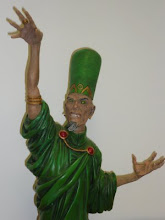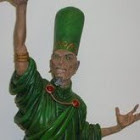 A very engaging and enjoyable anthology that takes a happily generous view of "Slice of Life" as the central theme for various comics in the collection. The wonderful diversity in the stories is never confusing or distracting, they comfortably sit along side each other.
A very engaging and enjoyable anthology that takes a happily generous view of "Slice of Life" as the central theme for various comics in the collection. The wonderful diversity in the stories is never confusing or distracting, they comfortably sit along side each other.Killing Action Man, Martin Feekins (Writer), Jonathan Scott (Art), Ken Reynolds (Letters), very sharply captures a moment in childhood when we fear that an attempt to evade consequences will be uncovered and the trouble doubled. Talking Action Man suffers in action and the pervasive fear and guilt that follows are conjured up with precision and detail, as is the outcome. The low key tone of the story captures the moment with rueful compassion for the terrors that no one else could see. Jonathan Scott's art is is perfect for the moment, it captures the look of comics from the time , 1968, without trying to copy them. The colours are a joy, they capture the nostalgia essential for the story to work. Ken Reynolds' letters are natural and easy to read, the sound effects are precise and perfectly placed.
7ER MONNEN, 7ER MONNEN: Narrative-Shmarrative , 7ER MONNEN IM NISCHT, Daniel Ableev, are three one page comics that feature a solidary stick figure in different contexts. The first one, 7ER MONNEN is a neat joke, strong colors and strong timing make it work. 7ER MONNEN: Narrative-Shmarrative is a second 4 panel comic that teases the reader to impose a narrative on the panels by developing the context in each one. Daniel Ableev is clearly enjoying himself and the reader gets to do the same. 7ER MONNEN IM NISCHT, is the third 4 panel comic and I did not get it at all, whatever the intent of the the creator it has evaded me completely.
Old Plymouth. Eric Gaghan (Writer), Gregory Floch (Art), Ken Reynolds (Letters), is the most conventionally "slice of life" of the the comics in the anthology. A father who is ill is talking to his son, telling old stories and memories that have shifted and changed in the telling. Maybe the father broke his nose in a boxing match or in a terrible car crash, maybe he met his wife in a casino or a run down pub it does not really matter. It is the telling and the listening that counts and Eric Gaghan writes with sympathy and humour about the telling. The care for the cast gives the stories a warmth that invites the reader into the listening. Gregory Floch's art brings out all of the nuances, told and untold in the stories, the expressive cast respond to each other, the smiles of the father and mother for each other are a treasure. The blue tone saturating the memories/stories gives the memories a soft focus while the action retains it force. Ken Reynolds' nicely differentiated lettering allows the layers of the story to sit next to each other without confusion.
Dreamscape 1: Nightmare. J.M.Bryan (Writer and Art) is a standout even in such powerful company. Writing a comic about dreams is a fantastically difficult problem to solve, the nature of dreams and dream logic is virtually impossible to express convincingly. There are no rules for talent, using abstract art and cunning placement of text J.M.Bryan creates the sensation of a dream in a comic without ever compromising either. Words, pictures and colours are used with disciplined simplicity and powerful effect.
Psychedelic Entropy. Kyle Huston (Writer), Caleb Lindley (Art), Ken Reynolds (Letters), fabulously overboiled writing that is heard as much as read follows the possible disintegration of a mind trying to cope with reality. The wonderful grandeur of the words come right up the limit of parody or outright pretentiousness, they never cross the line because they are anchored so firmly by the stunning art. Caleb Lindley manifests the words in the art that holds the slippery ideas so firmly that the intent is allowed to be revealed. There is a joyous tension between the flight of the words and ideas and the huge physical weight of the art, the balance is a substantial pleasure to read. Ken Reynolds' letters are hiding their craft in plain sight, they never draw attention to them selves while to bind the whole comic together.
Child Gunther. Bob Schroeder is wonderful, the strongly expressive and dominant art is astonishingly stylised and completely engaging. The story of how a picture of a child was used for years on Kinder chocolate bar, steadily modified over the years is captured with great force and expressiveness. The lettering is as forceful as the art, big blocks of text compete with and try to crowd out the art. The reader is forced to choose one or the other concentrate on at a time. The competition works because the art is so expressive and powerful, it can tolerate the force of the text and incorporate it into the overall scheme. A intriguing story that is served by the powerful artistic imagination of Bob Schroeder.
Without You. Kim Roberts (Writer), Denis Vermesse (Art), Ken Reynolds (Letters) takes an unexpected perspective on a delicate issue. Getting a diagnosis of cancer is such an all encompassing moment that capturing it without without over or underplaying it is extremely difficult. Kim Roberts manages this by taking a deeply unexpected view that reveals the impact, the struggle and outcome with a honest and understanding eye. The art by Denis Vermesse is carefully set up to capture the progress of the story, the passage of time and the ebb and flow of the cancer. The panels control the timing of the story, the overlays capture the rest. The combination is wonderful, the reader is pulled in and along without ever being delivered to false sentiment, the art amplifies every delicate nuance of the writing. Ken Reynolds's letters give the voices clarity and shape, allowing everyone to be heard.
In addition to the comics there is a review of Sticky City, a graphic novel by Joe Bloch. The preview pages of Sticky City are great, strongly expressive, highly disciplined art that looks spontaneous and is clearly the result of deliberate artistic consideration.
Sliced (Quarterly). An Experimental Comic Anthology lives up to its title, the comics are outstanding, made by creators who understand the potential of comics and have the talent and creative muscle to achieve their ideas.
Chief Wizard Note: This is a review copy very kindly sent by Ken Reynolds. To get a copy of Sliced (Quarterly). An Experimental Comic Anthology. Issue 6, and you should because wonderful, creative comics are a reminder of the joy of living, it is available from www.slicedquarterly.co.uk


No comments:
Post a Comment